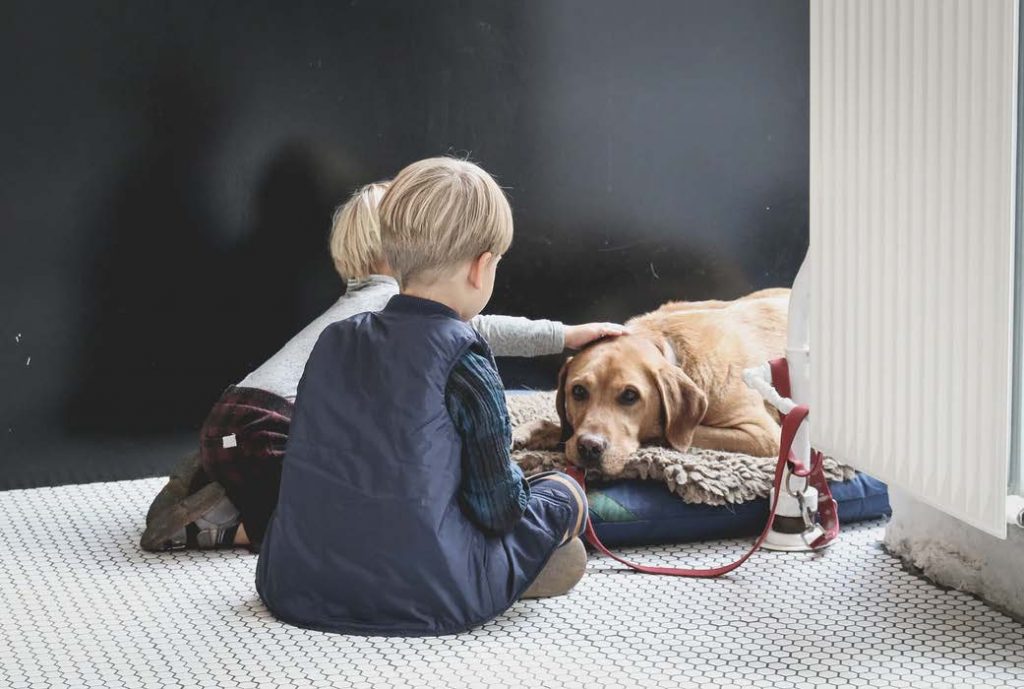Even though you may not necessarily mind your dog in bed with you, certain dog trainers will advocate that dogs used to sleeping in beds are susceptible to behavioral problems. While there is no science to back this up, there are many reasons that owners choose not to have their dogs in bed with them.
We love our dogs and want to give them attention and spend time with them, but this can be troublesome with the dog in bed when it is time to sleep. Dogs might shed all over your sheets, move around frequently during the night, or snore too loud for you to get adequate rest. In some cases, letting the dog sleep alongside you in bed leads to an undermining of leadership, giving your dog the impression that it is in charge.
Sometimes, owners don’t realize that having room to sleep on the bed becomes an issue when they grow, especially if they have the dog when it is just a puppy to start. Another potential problem is that jumping on and off the bed can cause injury or pain in joints due to the required movements, not to mention if they accidentally have a fall.
If you are adamant that your dog discontinue sleeping in the bed with you, it can be challenging to train if they are already accustomed to sleeping in your bed. However, there are plenty of tactics and techniques you can instill to help your dog learn not to sleep with you in the bed any longer.
 “Letting your dog sleep in your bed can strengthen the emotional bond and provide comfort for both pet and parent, but it’s important to recognize the trade-offs. While co-sleeping can ease anxiety and deepen trust, it can also disrupt sleep quality, reinforce dependency, or cause issues for dogs who struggle with boundaries. Like all things in pet parenting, balance and consistency are key.” – Kevin Kinyon, Co-Founder, Petworks.
“Letting your dog sleep in your bed can strengthen the emotional bond and provide comfort for both pet and parent, but it’s important to recognize the trade-offs. While co-sleeping can ease anxiety and deepen trust, it can also disrupt sleep quality, reinforce dependency, or cause issues for dogs who struggle with boundaries. Like all things in pet parenting, balance and consistency are key.” – Kevin Kinyon, Co-Founder, Petworks.
Create A Designated Sleeping Area
Since your bed is out of the question, your dog needs to have a spot to sleep in at night. Many parents like the option of purchasing a dog bed or mattress to give their down its own designated place somewhere either in the room or in the home.
Bond Vet Animal Hospital emphasizes that when deciding on an area for your dog to sleep in, you want to be mindful of your dog’s sleeping habits and what bed or mattress can help provide comfort good night’s sleep. They implore you to analyze how the dog sleeps, paying close attention to the position it tends to sleep in at night. Knowing these two things can help you decide on the right area and bed or mattress to give your dog as much room and comfort as necessary.
Sometimes dogs do not take to beds or mattresses, and you can create a more simple place for your dog to lay with a blanket or pillow. It will help if your scent is on it, too – creating the illusion for your dog that you are close by and helping with the transition off the bed.

Train Your Dog to Learn a New Command (or Two)
If you want to train your dog to stay off your bed (or any furniture, for that matter), you can adapt to teach it the “off” or “down” command. If this is a new command you are teaching your dog, it can be established by initially guiding your pet down from the bed repetitively and using the command each time.
Remember that it takes time to train your dog in something new, especially if it is not a puppy. You might have to use ‘no’ multiple times throughout your training. In some cases, your dog will want to get out of its own bed or sleeping area and get into yours, and you will have to give it a firm ‘no’ and “go to your bed.” Try not to pick them up and place them back in their own bed. Just give them a nudge in the direction of their bed so that they learn to go to their spot willingly.
If you happen to catch your dog in the act of getting up onto the bed or already laying in bed, then you can use the commands “off” or “down” to drive impact and help it to learn. Do not reward your dog with any treats or petting it unless it obeys the command – only then should you reward the behavior since it got off the bed.

Did you find this article useful? Would you like 100% free access to more articles like these, and free access to over 5,000 vetted pet care service professionals throughout the United States? Sign up here for a free Petworks account, and take 10% off your first booking, on us!
Create Distractions
If you have an area for your dog to sleep in, work to lure your dog to that place when you sense it will lay down. You can make the sleeping area, mattress, bed, or blanket more appealing by putting some of their favorite toys or treats there. The dog will associate the spot with its favorite toys or treats and likely be more apt to head in that direction rather than try to get up onto the bed.
Another way to distract your dog from wanting to go into your bed at night is by tiring it out. Play with your dog or take it on a long run or walk so that your dog is too tired to put up a fight about where to sleep when it is time for bed. If you do this, it can also help to ensure your dog gets a good night’s sleep. Try to avoid forcing your dog to lay in its designated spot or bed. Your dog will associate a lousy experience with the location and be less likely to want to go to that spot.
Your dog might whine or whimper while getting used to its new sleeping area. Do not yell at your dog, punish it, or tell it to be quiet; just work to ignore the noises. The dog will do this only to get your attention in hopes that you will give it what it wants. Once your dog realizes that it will not be catered to, it will cease this behavior.
Making Corrections
While correcting your dog’s behavior, be sure to stay calm and use positive reinforcement. Each time your dog successfully makes its way to its own bed, reward it with a treat or a friendly pet. The sleeping area is there as a positive and happy place for your dog to sleep, and the goal is that your dog will enjoy going there to sleep. Training your dog to no longer sleep in your bed will take some practice and patience.
If you’re having trouble or need more assistance, you can always look to hire a professional. Be sure that your dog knows who is in charge (you) and that it can still have plenty of cuddles and playtime with you, regardless of where it sleeps. Your furry companion is still your best friend, even if you don’t sleep in the same bed.
About the Author
 Nicole McCray is a die-hard animal lover who has worked in pet care for years. She is a former vet technician, a dog mom to her two rescue pups, and she grew up living and working at her family’s pet boarding facility. She loves using her writing talents to share the insight she’s learned throughout her career in the hopes that her knowledge can help other pet parents out there!
Nicole McCray is a die-hard animal lover who has worked in pet care for years. She is a former vet technician, a dog mom to her two rescue pups, and she grew up living and working at her family’s pet boarding facility. She loves using her writing talents to share the insight she’s learned throughout her career in the hopes that her knowledge can help other pet parents out there!
About Petworks
 In 2021, Dr. Marty Goldstein DVM joined the pet care platform Petworks as an advisor in its Animal Nutrition care division. Dr Marty Nature’s Blend is on a mission to help your pets live their healthiest lives possible. Dr. Marty’s pet nutrition expertise and guidance has helped Petworks evolve and become the preeminent animal and pet nutrition consultation service for pet parents in North America.
In 2021, Dr. Marty Goldstein DVM joined the pet care platform Petworks as an advisor in its Animal Nutrition care division. Dr Marty Nature’s Blend is on a mission to help your pets live their healthiest lives possible. Dr. Marty’s pet nutrition expertise and guidance has helped Petworks evolve and become the preeminent animal and pet nutrition consultation service for pet parents in North America.
 In 2022, Blue Buffalo Founder Bill Bishop Jr. joined Petworks as Senior Advisor in our Animal Nutrition Care Division. Bill brings his extensive expertise in pet food innovation and business leadership. His guidance helps Petworks enhance our pet nutrition service offerings, helping to ensure that pet parents throughout the world receive trusted, science-backed nutritional support for their dogs, cats, and animals.
In 2022, Blue Buffalo Founder Bill Bishop Jr. joined Petworks as Senior Advisor in our Animal Nutrition Care Division. Bill brings his extensive expertise in pet food innovation and business leadership. His guidance helps Petworks enhance our pet nutrition service offerings, helping to ensure that pet parents throughout the world receive trusted, science-backed nutritional support for their dogs, cats, and animals.
Petworks Co-Founder Kevin Kinyon is a life-long animal lover who works tirelessly to improve the lives of pets and their parents. Human and animal qualities he values most are integrity, humor, and empathy.



